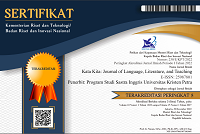PROJECT: SCREENPLAY FINDING ANDY
DOI:
https://doi.org/10.9744/katakita.5.1.136-141Keywords:
Café, Interior, Jakarta, Mini Cinema, Record StoreAbstract
This paper is about my screenplay entitled Finding Andy which I use as my final project. The screenplay itself is a story about a teenage girl who wants to improve her family’s poor communication. For my theory, I use John Gottman’s “The Four Horsemen of the Apocalypse Model” about family conflict. The theory helps me to shape my characters’ behavior towards each others. Since my characters has better relationship even though the brother dies in the end, I tend to use the worst level of family conflict in the beginning of the story and it gradually changes into successful communication which leads to good relationship. The theory helps me to give example of family’s poor communication to the audiences. I also do an observation on some families with poor communications and Rangkah Rejo neighborhood in Eastern Surabaya to build the setting’s circumstances. From this creative work, I expect that it is made into films, like what screenplay is for, so that the audiences realize that this kind of family exists.
References
Garling, Tommy &Valsiner, Jaan (1985). Children Within Environments: Towards a Psychology of Accident Prevention. New York: Plenum Press.
Gottman, J. M. (1994). Why marriages succeed or fail. New York: Simon & Schuster.
Karg, B., Sutherland, R., & Over, J. V. (2007). Everything Filmmaking Book. Massachusetts: Adams Media.
Letwin, D. Stockdale, J. Stockdale, R. (2008). The Architecture of Drama. Maryland: Scarecrow Press, Inc.
Malatesta, Mark (2013). Family Saga Genre—Complete List of Book Genres. Retrieved from http://book-genres.com/family-saga-genre/
McFarland, Richard A., (1981). Physiological Psychology: The Biology of Human Behavior. California: Mayfield Publishing Company.
McKee, R. (1997). Story: Substance, Structure, Styles, and The Principles of Screenwriting. New York: Harper-Collins Publisher, Inc.
Pickhardt, Carl E. (2011). Adolescence and Parental Authority. Retrieved from https://www.psychologytoday.com/blog/surviving-your-childs-adolescence/201105/adolescence-and-parental-authority
Pringle, Mia Kellmer, (1980). A Fairer Future for Children. London: THE MACMILLAN PRESS LTD
Reiner, Rob (2009). The Difference Between Stage Play & Screenplay for A FEW GOOD MEN. [Video]
Sloan, Alfred P. (2007). Family Talk: Discourses and Identity in Four American Families.New York: Oxford University Press, inc.
Spock, Benjamin (1962). USA: The Curtis Publishing Company.
Turner, Lynn H., & West, Richard (2006). Perspectives on Family Communication. New York: The McGraw-Hill Companies.
Whitfield, Charles L. (1987, April 1). Healing the Child Within: Discovery and Recovery for Adult Children of Dysfunctional Families [Book]Health Communications
Wiley, John(1954). Manual of Child Psychology.USA: John Wiley & Sons Inc.
Downloads
Issue
Section
License
Authors who publish with this journal agree to the following terms:- Authors retain copyright and grant the journal right of first publication with the work simultaneously licensed under a Creative Commons Attribution License that allows others to share the work with an acknowledgement of the work's authorship and initial publication in this journal.
- Authors are able to enter into separate, additional contractual arrangements for the non-exclusive distribution of the journal's published version of the work (e.g., post it to an institutional repository or publish it in a book), with an acknowledgement of its initial publication in this journal.
- Authors are permitted and encouraged to post their work online (e.g., in institutional repositories or on their website) prior to and during the submission process, as it can lead to productive exchanges, as well as earlier and greater citation of published work (See The Effect of Open Access).














